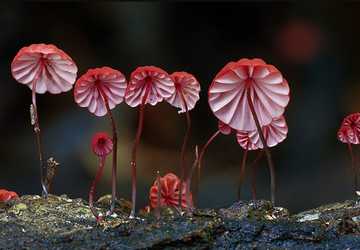How to Take Breathtaking Nature Photography
Nature's beauty is all around us, waiting to be captured through the lens of a camera. Whether standing atop a majestic mountain, peering into the depths of a lush forest, or watching a bird in flight, nature photography allows you to freeze these moments, preserving them for others to marvel at.
In this guide, we'll explore the art of taking breathtaking nature photographs, regardless of your skill level or the equipment you have. We'll delve into the techniques, tips, and approaches that can transform your snapshots into stunning works of art, all while keeping things simple and accessible.

1. Equipment Matters, but It's Not Everything
While professional cameras and lenses can yield stunning results, don't let a lack of high-end gear deter you from nature photography. Start with what you have, whether it's a smartphone or a basic point-and-shoot camera. Modern smartphones offer impressive photo quality, making them great tools for beginners.
Focus on understanding your equipment's limitations and strengths. Experiment with different settings and modes to get the best out of your gear. Remember, it's the photographer's eye and creativity that truly make a photo exceptional.
2. Master the Art of Composition
Composition is the foundation of a captivating nature photograph. Keep these basic rules in mind:
Rule of Thirds: Divide your frame into vertical and horizontal thirds. Position key elements along these lines or at intersections to create a balanced and visually appealing composition.
Leading Lines: Use natural elements like rivers, paths, or branches to guide the viewer's eye into the image.
Framing: Frame your subject with environmental elements, such as overhanging branches or archways, to add depth and context to your shot.
Foreground and Background: Include elements in the foreground to add depth and interest, and pay attention to the background to avoid distractions.
3. Timing is Everything
Patience and timing are essential in nature photography. The perfect moment often lasts seconds, so be prepared to wait for the right conditions and light. Early mornings and late afternoons offer soft, warm lighting that can transform an ordinary scene into a breathtaking one.
Consider the seasons and weather when planning your shoots. Each season brings unique colors and moods; dramatic weather can add depth and emotion to your photos.
4. Connect with Your Subject
Understanding your subject is crucial. Take time to observe and connect with the natural world around you. Study the behavior of animals, the flow of water, or the growth patterns of plants. This knowledge will help you anticipate the best moments to capture.
To photograph wildlife, use telephoto lenses to maintain a safe distance while capturing detailed shots. Be patient and respectful, allowing animals to behave naturally without causing distress.
5. The Magic of Macro Photography
Macro photography is a window into the tiny wonders of nature. Invest in a macro lens or use the macro mode on your camera to capture intricate details, such as dewdrops on a leaf or the delicate patterns of a butterfly's wings.

To get the best results, use a tripod or stabilize your camera to avoid blurry images, as macro photography is highly sensitive to movement.
6. Don't Forget About Light
Lighting is the heart and soul of photography. In nature photography, the quality and direction of light can transform your images. Learn to read and work with natural light, adjusting your composition and angles accordingly.
Backlighting can add a magical glow to your subjects, while side lighting can emphasize textures and shapes. Avoid harsh midday sunlight when shadows can be too intense. Cloudy days can offer diffused light that softens contrasts and enhances colors.
7. Use Filters for Impact
Filters are valuable tools for nature photographers. A polarizing filter can reduce reflections and enhance colors, making skies bluer and water clearer. Neutral density filters allow for longer exposures, capturing the motion of flowing water or creating dreamy effects in landscapes. Experiment with filters to see how they affect your photos and adapt them to suit your creative vision.
When using filters, it's important to remember that subtlety often yields the most remarkable results. A slight adjustment with a filter can make a significant difference in your image. Take the time to learn how different filters interact with varying light conditions and subjects.
8. Experiment with Different Angles
Don't settle for the typical eye-level perspective. Change your angles to find unique and compelling views. Get down low to capture the perspective of small creatures or look up to emphasize towering trees and cliffs. Climb hills, wade into streams, or lie on your back; the effort you put into finding fresh angles can result in extraordinary shots.
Remember that nature offers an endless array of possibilities regarding angles and compositions. Take the time to explore your surroundings fully. Sometimes, the most captivating shots are waiting just a few steps away from the well-trodden path.
9. Post-Processing for Enhancement, Not Transformation
While post-processing can enhance your photos, it's essential to maintain the authenticity of the scene you captured. Adjust exposure, contrast, and color balance to bring out the best in your image. Use software like Adobe Lightroom or mobile apps to fine-tune your photos.
Avoid heavy-handed edits that create unrealistic or overly dramatic effects. Strive for a balance that preserves the natural beauty of your subject.
10. Practice, Learn, and Explore
Becoming a skilled nature photographer takes time and practice. Don't be discouraged by initial setbacks or uninspiring shots. Instead, use every opportunity to learn and grow. Analyze your work critically, seek feedback from others, and never stop exploring new locations and subjects.
Remember that every photographer has their unique style and perspective. Embrace your creativity, experiment with different techniques, and, most importantly, enjoy the journey of capturing the breathtaking beauty of the natural world through your lens.
Conclusion
As we wrap up our journey into the captivating world of nature photography, remember that every click of your camera is a chance to connect with the natural world and share its beauty with others. Whether you're a novice, a passionate enthusiast, or a seasoned pro, the allure of nature's wonders remains constant.










